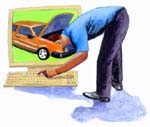Customization based on consumer preferences was clearly not a part of Henry Ford’s thinking. As legend has it, when the founder of the Ford Motor Company was asked about varying his Model T just the tiniest bit, Ford said gruffly, “They can have any color they want, so long as it is black.” But that is not the way to survive now in the automobile business, said James Yost, Ford’s vice president and chief information officer, during a Wharton e-commerce seminar on October 4. “Job One is now the customer. It is the basis for shareholder value. We used to be a manufacturing company which made great products. Now we want to be known as the consumer company in the automotive space.” To this end, Ford, like the other automotive companies, is looking to e-commerce to expedite its connection to consumers. Yost estimated that at least 60% of the people who come to a Ford showroom are armed with information they have gotten from the Internet. Some of that, of course, has come from Ford or Ford dealership web sites. But wherever it comes from, it has changed the relationship of dealer and customer. “In the past, the dealer was the one who had all the information. Now the dealer, instead of being the information source, has to be the consumer’s helper,” said Yost. “All through industry, knowledge assets are going to be valued more than physical assets. Cisco is one of the most valuable companies in the world and it has very few physical assets. It only owns two factories outright.” Ford will never be that bare of assets. It intends to be making cars for a long time. But the information that consumers have access to has meant thinner margins on auto sales. Consequently the main tactic now is to create lasting relationships with customers. “You can look to a company like Harley-Davidson to see what I mean,” said Yost. “They may or may not make the best product, but they make a product that inspires loyalty. People come to the showroom for an experience. There are pool tables. There are Harley-Davidson restaurants. There are clubs .. This is a consumer loyalty business.” While consumers probably won’t encounter pool tables or restaurants any time soon at their local Ford dealerships, the mission for the company is to keep the customer after he or she has purchased a car. Yost said that the average customer now spends $68,000 during the life of a car, with only about $24,000 of that on the purchase itself. “This is not a philanthropic business. We want that other part of the spending,” he said. “The service end has higher margins and we have to put more resources into that.” To that end, Ford is looking to the Internet to give customers more information. It is launching a program called Ford Direct this fall to co-ordinate dealership web sites with the main company sites. There will be more informational web sites for consumers and more connections later to inform them of specials, updates and service options. On the business-to-business end, Ford has entered into a web-based parts-and-supplies consortium with General Motors, Nissan, Daimler-Chrysler and Renault called Covisint. “The supply chain had too many middlemen. This will make for great efficiencies,” said Yost. Already, he added, Ford has seen an 18% drop in prices for parts and supplies. But the real test will come in the future, when consumers start demanding virtually customized cars, straight from the factory. “The Internet may drive down the price of cars, but more important, it will change the way people buy them,” Yost said. “They are going to want personalization, not just something off the rack. It will come down to how quickly we can provide that. The end game is to be flexible enough in design and engineering so each customer can have options in ordering.” Yost thinks there will always be dealerships, if only as showrooms. “Cars are an emotional purchase. People still want to kick the tires, to drive the car. We may have fewer models on the lot, which is actually a good thing, since too much inventory there means selling cars for less of a profit. “But all that will benefit the consumer, too. He won’t be inclined to buy a car he doesn’t really want just because it’s a few dollars off and it’s on the lot. In the last analysis, we no longer just want to sell a car, but to have a long-range customer for all the car services. We intend to use e-commerce to accomplish that.”
Looking for more insights?
Sign up to stay informed about our latest article releases.



